Red Fox Senses
Foxes are superb hunters with a finely-tuned battery of senses that allow them to interpret the world and respond accordingly to catch their prey. Curiously, despite having been farmed and studied for decades, there are surprisingly few empirical studies on fox sensory biology; much of the information we currently have is either based on behavioural observations or extrapolated from dogs.
All the better to see you with - fox vision
Anyone who has watched a fox flee from a disturbance in the field will have noticed how they move quickly through scrub and woodland, squeezing under fences and gates, making jumps over ditches, running along walls and fences and navigating through bramble; all this conducted at some considerable speed. All the forgoing implies that foxes have good visual acuity at short-range. My own experience watching foxes suggests that, at longer distances, they are good at picking out certain shapes and contrasts (i.e. the human form on the horizon but not against a low contrasting background such as a tree or hedge) and, at any distance, they’re very sensitive to movement.
Several authors have noted how a hunting fox will often walk straight past stationary beetles or crouching rabbits, suggesting that their vision (or certainly their hunting instinct) is based largely on movement. Indeed, foxes probably have a fairly low-resolution visual system that may make the hunting of small, stationary objects that cannot be isolated by either smell or sound, almost impossible. The reason for this, as we shall come to shortly, lies in the type of cells predominant on the retina. The subject of whether foxes see in colour is covered in a separate QA, but it is worth briefly looking at the more general aspects of their visual system.
Cat-like pupils & bright carpets
Foxes are, in visual terms, arrhythmic (or 24-hour) mammals, meaning they can be active at any time, day or night (compare this to most squirrels, who are almost totally blind at night and can only be active during daylight). There are several adaptations that allow for this activity pattern; all help control the amount of light available to the animal. Foxes, unlike most canids, have vertically-slit pupils, which provide them with three significant advantages over hunters with round pupils. Primarily, vertically slit pupils can be closed more tightly than rounded ones and this, in conjunction with eyelids that close horizontally, allows their owner to more precisely regulate the amount of light entering the eye, helping them hunt across a wide variety of different light conditions.
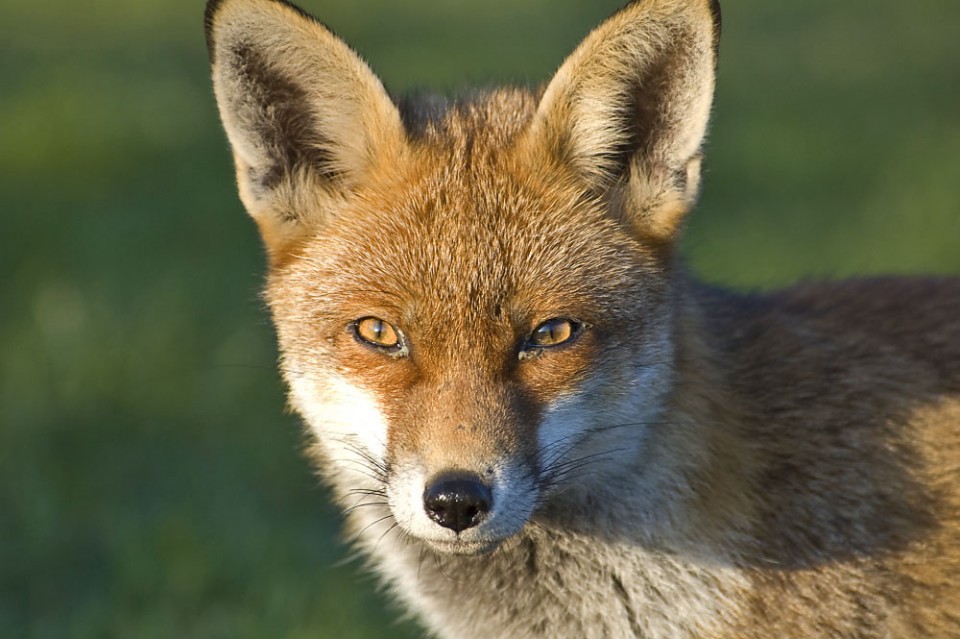
Secondly, vertically slit pupils may help the fox pinpoint horizontal movement. In a 1907 paper on ‘slit-form pupils’ Toronto University psychologist William Abbot suggested that a vertically-slit pupil may help a predator to focus sharply on small, ground-based prey as it moves laterally along the horizon.
Finally, we now think vertically-slit pupils help improve the quality of their vision in very bright conditions. As the photographers among us know, focal length is a mathematical function of the wavelength of light and the size of the aperture (hole) through which it passes. We don’t need to worry about the specifics here, but basically when light hits the lens it is bent (refracted) differently according to its wavelength – short (blue) wavelengths are refracted less than long (red) wavelengths. The refraction of the light then affects where it ends up being focused in the eye. If the light hits a uniform lens the short and long wavelengths end up being focused in different planes and the result is a hazy/blurred image.
Many species that have colour vision, including foxes and cats, get around this by having a “multifocus lens”. Now, this doesn’t mean that more than one part of a scene is in focus at the same time – instead their eye lenses have concentric rings in them, each of which focuses a different wavelength of light. In low light, there’s no problem, because the pupil is wide open and the whole lens (and all its rings) is exposed; but, when the pupil contracts in bright light an issue can arise because the pupil covers the outer ring(s) and this prevents that wavelength of light being focused, resulting in a hazy image. A fox’s slit pupils, however, neatly reduce the amount of light entering the eye (preventing the retina being damaged) but still expose all the rings of the lens, allowing different wavelengths to be properly focused and reducing the blur.
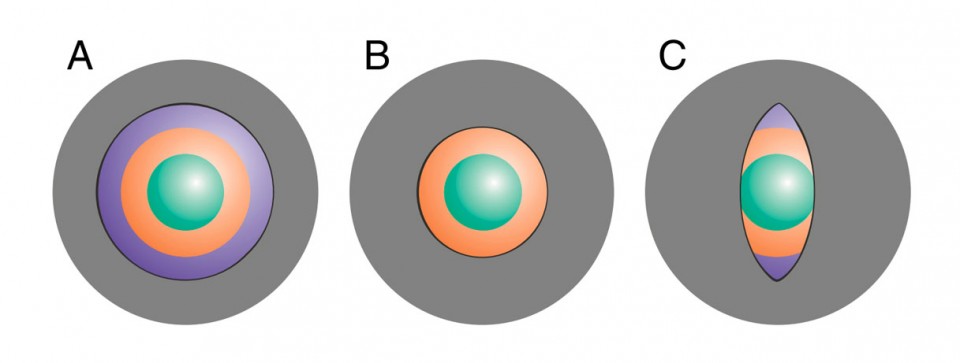
The iris of an adult fox is typically a stunning bright amber/yellow colour, owing largely to the pigment lipochrome (other factors such as the cellular structure, texture and pigment combinations control the precise colour and brightness); it is unknown what, if any, benefit foxes get from having an iris this colour, but it has been suggested that in some mammals (squirrels, for example) it may act in a similar manner to sunglasses, reducing glare in bright light. So, these features can help control the amount of light entering the eye during daylight, but foxes also have a neat anatomical feature that helps to boost the light available at night.
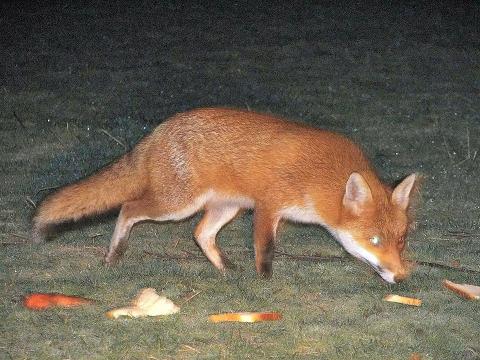
Foxes, like many animals, have a tapetum lucidium (from the Latin meaning ‘bright tapestry’), which is a collection of highly organized reflective cells (called leucophores) that form a layer behind the retina. There are several different types of tapetum, classified according to the structure and arrangement of the cells; the specifics don’t really matter to us, but foxes, like other carnivorans have a choroidal tapetum cellulosum. The cells of the tapetum are rectangular in shape and contain reflective material varying in size and shape; these cells are retroreflectors, which means they reflect light back along the same path it arrived on. Basically, this means that light passing through the retina (that in humans is lost) is reflected back into the eye, improving the night-vision of the fox.
The fact that the light is reflected back along the exact same path it comes in on helps maintain the sharpness and contrast of the image on the retina (although there is probably still some blurring). The tapetum is also responsible for the eye-shine that is a familiar sight for anyone who’s ever shone a torch into a field at night or taken a flash photo of their pet. Humans lack a tapetum so in flash photos the light is reflected back by the blood in the retina (causing the red-eye that blights many party photos).
In foxes (and most other mammals, for that matter), the tapetum bounces the light back into the eye and gives the impression that the eye is glowing – it isn’t glowing, merely reflecting light back at you. I am often asked what colour fox eye-shine is, but this is no fixed colour because this phenomenon is a form of iridescence – in other words, the colour of the reflected light can vary depending on the angle from which it is viewed. Nonetheless, in my experience and that of others, eye-shine tends to be blue or green, although yellow/orange or red is sometimes reported.
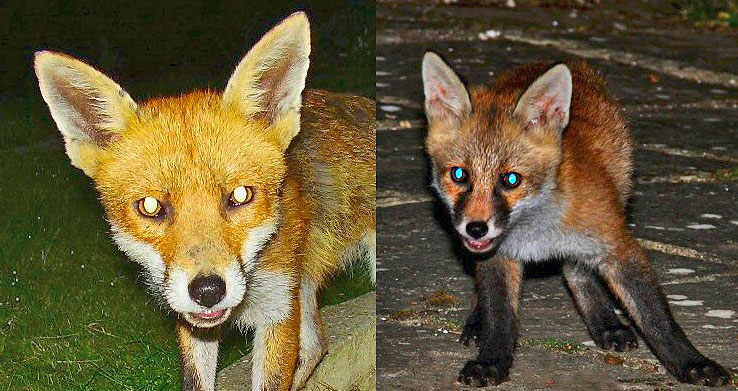
Interestingly, I have heard it suggested that cubs or subadults have a different eye-shine colour to adults (green or dull yellow compared with bright yellow or red) and in my experience, cubs often display a turquoise/blue eye shine. Part of any difference between the cubs and adults may be a result of the cubs being lower to the ground than adults (affecting the angle of reflection), but it may also be related to the development of the tapetum. I know of no data for foxes, but in cats and dogs the tapetum isn’t fully developed until the animal is about four months old.
Light detection - rods & cones
There are two main types of light detecting cells on the retina of the fox: rods and cones. The two cells differ in various ways; most notably in their sensitivity to light and how they’re wired into the brain. Rod cells contain a single pigment, called rhodopsin, which is sensitive to ‘blue/purple’ light (peak sensitivity at wavelength 496 nanometres); consequently, rods cannot discriminate between colours and are used only for determining brightness. (I should point out that light isn’t coloured, it’s all just photons. The reason it appears coloured is because different frequencies of photons stimulate different retinal cells and our brain interprets this electrical impulse as red, green, or blue.)
Rod cells are very sensitive to light and several are attached to a single neuron. The result is that the cells can be stimulated by only a few photons (particles of light) and several rods can act together to stimulate a single neuron (sending an electrical signal to the brain, which is used to build an image). The brain cannot, however, tell which of the cells in the ‘rod bundle’ was stimulated, so it can’t interpret the exact size or shape of the object being looked at. In essence, the rod system is a high sensitivity but low acuity system – it’s superb for letting the animal pick out objects in low light (such as that around twilight and at night), but the picture the animal sees is colour-less and lacks detail.
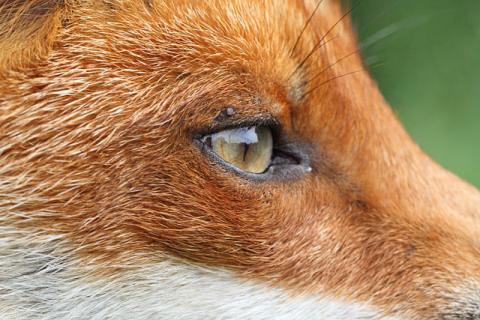
Cones, by contrast, are almost the exact opposite: they work in bright light, there are fewer per neurone (one per neurone in some parts of the retina) and they contain different pigments that allow the perception of colour. Among mammals there are three ‘types’ of cone cell (they look the same, but contain different light-sensing chemicals, called photopsins or photopigments): those that detect long-wave (red) light (L cones); those that detect medium-wave (green) light (M cones); and those that detect short-wave (blue) light (S cones). Cone cells are less sensitive to light than rods, so more photons must strike them before they are stimulated to send a message to the brain – the result is that they need relatively bright light to function (making them useless at twilight or at night), but in return they can detect more detail and register rapid or subtle changes in an image that rods would miss.
Ultimately, if you had a retina composed entirely of cones you’d be great at spotting things and recognising objects during the day, but blind in dim light. Conversely, rod cells become saturated in light levels much beyond those produced by a 20-watt light bulb, making them useless during the daytime. Consequently, animals that are active during the day and night have a retina with both rod and cone cells; the systems swap over as light levels rise and fall. Sometimes this swap over is quick (i.e. when cones take over from rods as you move from a dark place to a bright one it takes only a few seconds to restore vision), while at other times it is much slower (i.e. when rods take over from cones as you turn off a light a night).
Foxes have a retina dominated by rods, but with a few interspersed M and S cones (no L cones, so they are essentially red-green colour-blind) arranged in concentric rings, or zones, on the retina – this setup is referred to as a multifocal optic system and helps the fox maintain colour vision in very bright light. Different colours of light are focused on different zones of the retina (hence the multifocal name); the slit pupil allows all the various zones to be used, even with the pupil reduced in size (see diagram). So, having a multifocal optic system means that, even in very bright light when the pupil has been closed down, some colour perception is still possible and this colour information can be used to resolve details in the image.
Essentially, a fox’s vision is adapted for twilight (crepuscular) and nocturnal activity. I’m not aware of any equivalent data on foxes, but it has been estimated that cats (which possess a similar eye structure, pupil and tapetum to foxes) can see in low light five-or-six times better than humans. (It should be mentioned that light is an essential component of the visual process, and no mammals can see in total darkness.) So, the large number of rods along with the tapetum give foxes much better night vision than we have, but they also have sufficient cone cells and a strictly controlled pupil that allow hunting during the daytime too, even if the picture they see is less detailed or colourful than the one we see.
Fox field of vision
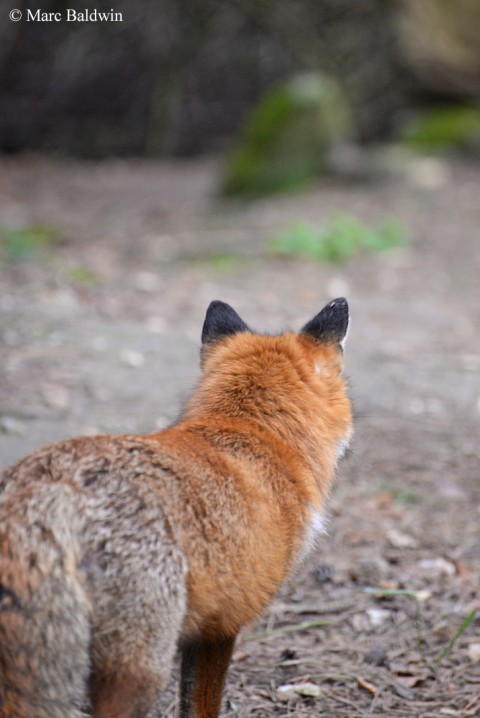
I have mentioned that field observations suggest foxes are myopic (short-sighted); it can run through vegetation without incident, but will approach stationary objects to within a few metres unless another sense alerts it to danger or the object moves. Having a retina dominated by rods (which are sensitive to short wave light) and lacking L cones altogether would certainly suggest that foxes are short-sighted. Moreover, in Town Fox, Country Fox, Brian Vesey-Fitzgerald notes that fox eyes lack a macula lutea -- the highly sensitive central part of the retina, containing the fovea, responsible for our perception of detail (without it, reading this website would be impossible) -- which means that foxes are unable to focus on stationary objects for more than a few seconds, again rendering them myopic.
In his The Red Fox, Huw Lloyd presented diagrams of the fox’s visual field and, based on these drawings, they have a field of view spanning roughly 260-degrees, with a blind-spot covering about 100-degrees directly behind their head and an overlap of fields of the right and left eyes of about 40-degrees (the degree of overlap is referred to as binocular vision and allows animals to judge distances).
To put this in context rabbits have a visual field of about 360-degrees (they’re only blind to a 10-degree area directly in front of their nose), but have a binocular overlap of only about 20-degrees; this makes them good at spotting foxes and photographers sneaking up on them, but poor at telling how far away the danger is. You, by contrast, can see objects within a horizontal arc of about 180-degrees directly in front of you (without moving your eyes or head), but about 140-degrees of this field is binocular overlap, making you very good at judging distance.
So, foxes have some binocular vision (more than rabbits, but substantially less than us), which is useful for scaling fences and chasing down prey. Lloyd also calculated the optic axis of the fox (this is the angle that the eyes look out relative to an imaginary line drawn down the middle of the body – see diagram) to be about 15-degrees, which means that their eyes cannot converge on a near object as well as ours can (humans have an optic axis of about 5-degrees). Overall, Vezey-Fitzgerald probably wasn’t too far off the mark when he suggested that foxes use their eyes to avoid objects, not recognise them.
The priority of vision
So, with this in mind, is vision an important sense for the fox? After all, it is not uncommon for old foxes to develop cataracts and at least one, other-wise healthy, blind fox was radio-tracked by the biologists in Oxford. In 1964, Finnish biologist Henrik Österholm published a paper in Acta Zoologica Fennica in which he assessed the role played by the fox’s various senses during hunting. Österholm concluded that vision is a key factor in finding food during daylight but it became less important at dusk and in the dark, when the fox relied much more on hearing. Overall, it seems that hearing was the most important sense, followed by vision and then smell – even at twilight, vision appeared more important than smell to the hunting fox.
Österholm also briefly tested for colour discrimination, using both squares of coloured (blue and green) card and different coloured porcelain eggs. He found that colour had no significant impact on the test foxes, while they all responded to the brightness of the eggs used (which is expected, given the domination of the rod cells in the retina); light eggs (e.g. white) were always preferred over dark (blue and red) ones, presumably because these were closer to the hue of a natural egg. Interestingly, Österholm found that although brightness was an important consideration, it was apparently subordinate to size and shape, concluding:
“If an object has the right quantities of size and shape it will be taken independent of the colour.”
Sight beyond sight? Geomagnetic vision.
Finally, on the subject of the importance of vision to hunting foxes, it has recently been suggested that foxes may be able to see the earth’s geomagnetic field (GMF) and use it to zero in on their prey thereby improving their hunting success. In a fascinating paper to the journal Biology Letters during 2011, a team of biologists at the Czech University of Life Sciences and the University of Duisburg-Essen in Germany reported their observations of 84 mousing bouts (where foxes jump high in the air and land on their prey, usually small rodents) in 65 locations across the Czech Republic between April 2008 and September 2010.

The biologists found that there was no significant difference between the direction in which the fox was facing when it pounced (the directional heading) and prey capture success when the fox could see its quarry. When the fox was hunting in long grass or snow, however, and couldn’t see its target, the researchers observed that three-quarters of successful pounces occurred when the foxes were facing north-east -- this was regardless of the time of day, wind direction or cloud cover -- with less than one-fifth of pounces facing any other magnetic alignment being successful. The biologists suggest that:
“… mousing red foxes may use the magnetic field as a ‘range finder’ or targeting system to measure distance to its prey and thus increase the accuracy of predatory attacks.”
It is suggested that foxes, like many other animals, may (thanks to cryptochrome proteins in their retina) see magnetic north as a shadowy ring; the fox could then line this ring up with (i.e. superimpose it over) the direction from which it hears its prey rustling. It may help to visualise this. Imagine wearing a miner’s helmet (a hard hat with a torch attached to the front); the torch points at an angle, illuminating a spot on the ground two metres (6ft) in front of you. Wherever you walk, that spot of light is always two metres ahead of you. Now, imagine that you hear something moving in the darkness and walk towards it until it’s in the beam of your torch – you now know that the object is two metres from you and, if you’re a fox and that object is a mouse, how far you have to jump to catch it. The authors suggest that foxes do the same thing; they align this ring up with where they hear the rustling coming from (like a target bulls-eye) and then they know how far away dinner is.
In summary we can say that the fox has some capacity for colour vision along with various adaptations that allow them to hunt in almost any light conditions. They have a relatively wide field of view, but limited binocular vision and focussing power. Their vision is heavily based on movement and this is more so during the day than at night. More rods are plugged into a single nerve than cones, so it takes a larger movement to register a change in the picture when the animal is using only their rods (at night) than when they’re using their cones (during the day). The need for a big change/movement and the limited focal power of the eye makes hunting small, stationary objects by sight alone very difficult, if not impossible, for the fox.
A good listener - fox hearing
Foxes have two highly mobile ears, the rigid ‘flaps’ (technically called the auricle or pinna, but sometimes referred to as ‘trumpets’) of which serve to catch and funnel sound down into the ear canal. The ears can be moved independently, allowing them to pinpoint the source of a sound. My observations suggest that Red foxes can rotate each ear by about 150-degrees in a single direction -- the right ear rotates clockwise and the left ear anticlockwise -- in order to pick-up sounds to the side and behind them. The ears are furred both on the back (with short hairs) and internally, with relatively longer hair – the function of this inner ear fur is presumably to help trap particles of dirt, preventing them from entering the ear canal.
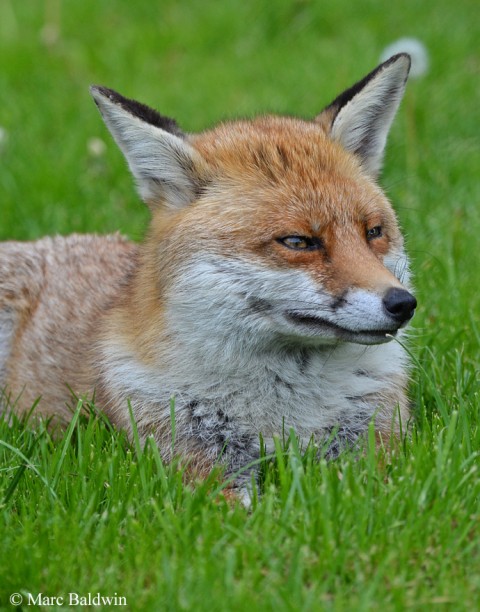
The ears are spaced apart, with the gap between them (the interaural or tympanic distance) varying according to sex, and from individual to individual; this separation means that sound coming in from either side will register in one ear fractionally sooner than the other, and the fox soon learns how to use this delay to pinpoint the source of a sound. The interaural distance in adult Red foxes is about three centimetres (just over an inch), which means that -- given various waveform properties that I don’t plan to elaborate on -- sounds between 5.5 and 11 kHz (see below) should be most difficult for them to locate.
Fox hearing is very sensitive to low frequency sounds; the rustling noises made by prey. Indeed, the base of the ear sockets of a fox's skull are fused into a bony air-filled chamber called the tympanic bulla. The bulla not only serves to protect the fragile inner ear bones, but it's division in half by a thin bony wall provides an extra echo chamber that we think helps the fox detect low frequency vibrations. When we talk about how well an animal can hear, there are two results that tend to be presented: the audible frequencies and the minimum audible angle (MAA).
Audible frequencies are the sounds that an animal can hear. Sound travels through the air in waves that peak and trough in a similar manner to waves on water, with one peak and trough considered a ‘cycle’; thus, a sound is described based on the number of cycles per second. Units for sound measured in this way are called hertz (abbreviated to Hz) and values are sometimes reported as kilohertz (kHz), meaning thousands of cycles per second; so 14,000Hz is the same as 14kHz. High-pitched sounds (such as the ‘treble’ on your stereo) have more cycles per second than low-pitched sounds (such as ‘bass’). In addition, scientists studying hearing often try to measure how good their subject is at telling a sound has moved from directly in front of them (a zero-degree angle): this is the MAA.
Under ideal conditions, humans tend to be able to distinguish sounds moving by a single degree either side of them, while fox squirrels, for example, have been shown to have MAAs of about 14-degrees. In other words, humans can tell a sound is no longer ‘dead ahead’ when it moves to either side by only one degree, while the sound must move 14-degrees to either side before a Fox squirrel would know it was no longer straight in front of them. So, in essence, the smaller the MAA, the more sensitive the animal is to the movement of a sound source (be it a speaker or a rustling vole). One final point to note is that high frequency sounds are more readily ‘dampened’ by the air and interfered with by objects in their path (a process known as attenuation), making them more difficult to pinpoint than low frequency ones.
Tuning in on prey
Henrik Österholm was one of the first biologists to systematically study the hearing capabilities of Red foxes, by using sound to guide his captive animals to a food reward. Österholm found that foxes could locate the food at all frequencies used (from 300 Hz to 15 kHz), but at higher frequencies an MAA of 10-degrees or greater was required. Between 300 and 700 Hz the foxes were almost spot on target (in at least 90% of cases they pinpointed the object), while they could locate the sound source to within 1-degree at frequencies between 700 Hz and 3 kHz. Foxes located the sound to within 2.5-degrees up to 15 kHz, after which they were less accurate. The striking trend in Österholm’s data is that the foxes were less accurate at locating the sound source as the frequencies increased and, overall, they were most sensitive to sounds of about 700 Hz.
Eleven years after Österholm’s work, Michigan State University ecologists Thomas Isley and Leslie Gysel published a paper in the Journal of Mammalogy in which they presented data on how well nine captive foxes located sounds of between 300 Hz and 34 kHz. The researchers found that the accuracy with which foxes located the sound increased gradually to 3.5 kHz, at which they were most sensitive; this is the frequency of sound produced by gnawing and rustling rodents and the calls of some gamebird chicks. Beyond 3.5 kHz the foxes were less accurate at finding the sound although, overall, they located sounds between 900 Hz and 14 kHz with at least 90% accuracy.
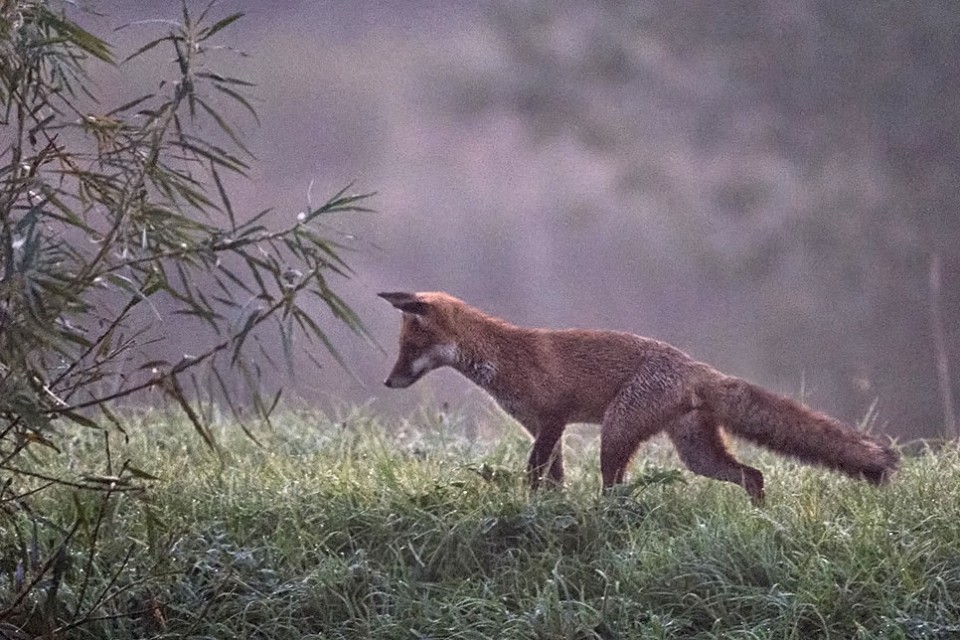
Isley and Gysel noted that their animals had most trouble locating sounds at 300 Hz, 600 Hz, 18 kHz and 34 kHz, although even at 31 kHz the foxes found the target 71% of the time; they also noted dips in sensitivity at 8.5 and 11 kHz. To give these results some context, humans (depending on age) generally hear in the region from 15 Hz to 20 kHz, with peak sensitivity between 2 kHz and 4 kHz, the frequency of human conversation. Similarly, when testing the audible thresholds of three young foxes in the Czech Republic, University of Duisburg-Essen zoologist Pascal Malkemper and colleagues found they could detect pure tones between 51 Hz and 48 kHz at 60 dB (i.e. covering the range of both the domestic dog and cat) with a peak sensitivity at 4 kHz. In their paper to Hearing Research in 2015, the biologists suggest that the high hearing sensitivity at 4 kHz might be linked to long distance localization of avian prey.
The different peak frequencies found by the different studies is interesting and may reflect that the Michigan and Czech biologists were using pure-tones, while Österholm’s sounds were impure (i.e. had a mixture of tones). This highlights that we must be careful when applying laboratory studies to the fox in the field.
For foxes, sound is important for various aspects of their daily lives. It is crucial for hunting and, Österholm considered that:
“… hearing has distinctly the greatest significance for locating the prey.”
Indeed, anyone who has watched a fox hunting in long grass will probably have noticed that the animal appears attracted by rustling among the vegetation, which it then seems to track by twitching and rotating its ears before pouncing. David Macdonald, in his experiments with a hand-reared vixen, found that she often caught undesirable small mammals (shrews, for example) because she didn’t know what she’d found until after pouncing and killing the prey – in other words, the fox was hunting largely by sound. Macdonald notes that beetles are caught in much the same manner, with one unfortunate insect being tracked down from 10 metres (30ft) away. Most hunters will attest to how foxes can be ‘called’ in from considerable distance using lures (whistles or squeakers that mimic the call of a favoured prey).
All this points to the importance of sound to the hunting fox. Still, sound is important for other aspects of fox life too. Foxes communicate, over both long and short distances, with sound and also use it to recognise possible danger. In his Town Fox, Country Fox Brian Vesey-Fitzgerald, who considered foxes to have better hearing than domestic dogs, told how a vixen he was watching apparently heard a man approach on soft earth some 30 seconds before he came around the blind bend 83m (272 ft) from the den.
The fox's sense of smell & taste
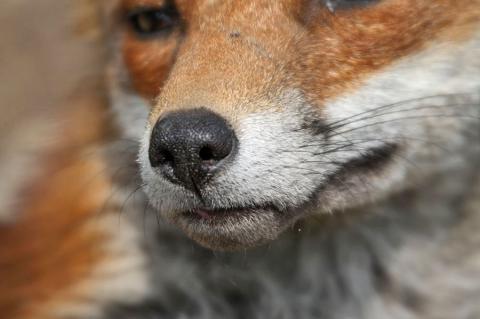
There are very few studies presenting empirical data on the fox's olfactory capabilities, and I’m not aware of any statistics on the number of receptive cells in the nasal epithelium or estimations of how many times better a fox’s sense of smell is over our own. Behavioural experiments and field observations suggest smell is an important sense and we know that scent plays a pivotal social function (see Communication), being used both to identify individuals and mark out territories (see QA: Why are foxes so smelly?), although it doesn't appear to be their keenest and there are conflicting reports of how easily foxes seem able to find prey by scent alone.
Foxes, like most mammals, possess turbinates -- convoluted bony structures in the nose that, as well as regulating the airflow within the nasal cavity, serve to increase the surface area of the olfactory epithelium -- and, as a consequence, the small snout can contain a considerable mucosal area. In essence, the larger the mucosal area, the greater the surface available for scent molecules to land on and the better the sense of smell. I'm not aware of any morphological studies documenting the nasal epithelial area in foxes, but domestic cats have about 21 sq-cm (3 sq-in), while a small dog -- a Cocker spaniel, for example -- has close to 70 sq-cm (11 sq-in). A fox probably lies somewhere in between; either way, this can be compared to humans that have, on average, 5 sq-cm (three-quarters sq-in).
Some naturalists have written of the fox’s ability to seemingly tell strangers from regular fox-watchers on the basis of scent alone. Vezey-Fitzgerald, for example, described how a vixen living in an earth opposite his house was used to the comings and goings of the local people but would suddenly freeze and ‘clap down’ when she caught the scent of a newcomer to the neighbourhood. My experience suggests that foxes spend a good deal of their time following their nose, which is constantly kept moist, thereby aiding not only the detection of scent trails (wet noses probably help improve scent detection by dissolving the chemicals in the air), but also helping the animal tell the wind direction.
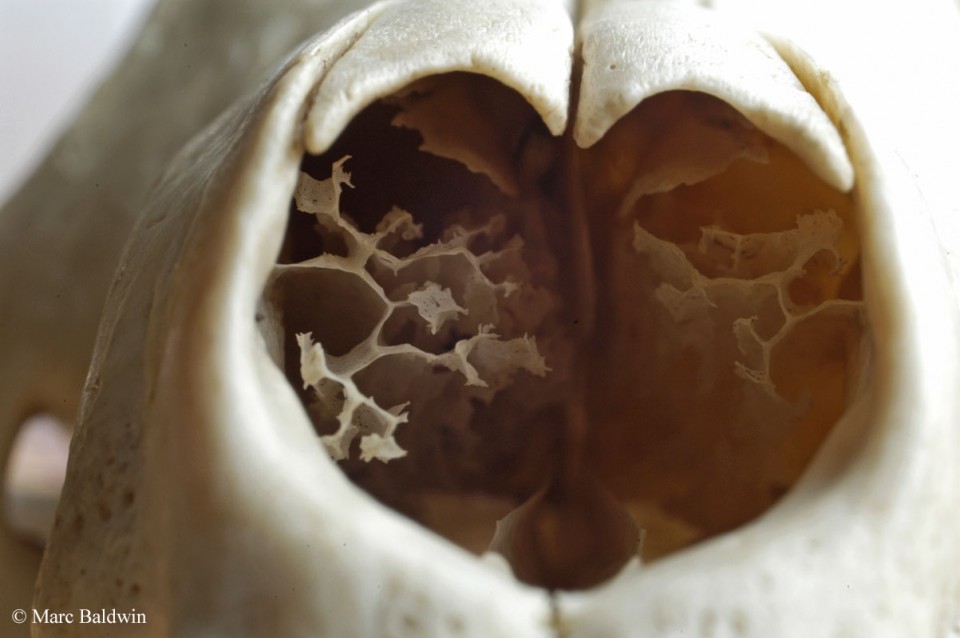
During his studies on captive foxes, however, Österholm found that his subjects couldn't find the pieces of meat he'd buried in a 10cm (4 in.) deep hole until they were within half a metre (2ft) of it, while pieces of meat sitting on the ground were only found when the fox was within two metres (7ft) of them. These results suggest that a fox's sense of smell is rather limited. In his 1980 book Red Fox, Huw Lloyd argued that Österholm’s studies, which used fresh meat, might yield different results if they were conducted with decaying flesh (given that foxes are well known to scavenge, and fresh meat has comparatively little smell). More recently, however, veteran fox biologist Stephen Harris described how foxes visting his garden struggled to find chunks of dog food (the smell of which Harris described as "strong and nauseating") or chicken scattered on his lawn. In an article to British Wildlife in 2020, Harris explained:
"The leaves were of the same colour as the pieces of chicken, and despite the latter's strong, greasy smell the Foxes had great difficulty in finding then chicken cubes among the leaves. They kept running over to investigate fallen leaves, either going right up to them or stopping within 30cm [12 in.] when they realised that it was not food. Often they would check a leaf which they had already investigated, and it was obvious that they were relying more on sight than on smell to find the chicken."
Inspection of the cribriform plate of red foxes suggests their sense of smell may actually be slightly poorer than other vulpids. The cribriform plate (CP) is a cup of perforated bone that sits in the skull and separates the olfactory bulb from the nasal chamber in mammals. In other words, passing through the holes in this bone is the only way nerves can connect the snout to the brain. As such, we think that the more holes (or more accurately foramina) in the plate, the better the sense of smell because the greater the number of nerves connecting the nose to the smell-interpreting parts of the brain. In a sizeable study of the CP in a variety of carnivores, a team of UCLA biologist led by Deborah Bird found that the plate in foxes is larger than, say, an Arctic fox (Vulpes lagopus) – with a surface area of roughly 640mm (25 in.) and 580mm (23 in.), respectively – but had fewer foramen; about 580 vs. as many as 646.
Foxes also possess a vomeronasal organ (sometimes referred to as Jacobson's Organ after the German anatomist who is often, erroneously, credited with its discovery), which opens into the roof of the mouth and is composed of tissue very similar to that found in the nasal lining; most mammals possess this organ and it appears to play a role in scent (especially pheromone) detection. This organ may help dog foxes assess how close to oestrous a vixen is based on subtle changes in her scent.
Some work has been done on the gustatory (taste) sense -- which is an extension of the olfactory sense -- of foxes and, in 1886 American doctor Fred Tuckerman described the tongue of the Red fox. Tuckerman’s data showed a tongue about 12cm (almost 5 in.) long and two centimetres (just under an inch) wide, with the texture of fine sandpaper, and suggested that foxes may have a less well developed sense of taste than we have, with fewer sour-sensing taste buds (vallate and foliate papillae).
Tactility - the fox sense of touch
A characteristic of mammals is the presence of fur/hair, one function of which is to help maintain body temperature. Some types of hair, however, can also have a tactile (touch) function, allowing their owner to feel their way around. Foxes have long (up to about 11cm / 4.5 in.), stiff specialized hairs known as vibrissae, or "whiskers", on their muzzles and forelegs (around the carpal or 'wrist' joint), which are associated with special nerve cells that are extremely sensitive to any contact – if you brush against a pet dog or cat's whiskers, you'll notice them sharply turn their face away. The carpal vibrissae are thought to provide the animal with information on its body position while hunting.
Studies of cat whiskers have found that the part of the brain that receives information from the vibrissae has a very similar structure to the visual cortex -- some authors have suggested that the same is true of foxes -- implying that it may help the animal build up a visual image of its surroundings, although they don't 'see' with their whiskers per se. Whiskers are embedded three-times deeper into the skin than other hairs and it has been demonstrated that, again in cats, when a prey item is too close for the animal to focus on it, the vibrissae are manoeuvred around the object so the cat knows where to bite. The whiskers also grow out to roughly the width of the body, so their owner is better able to judge whether they will fit through a given gap.
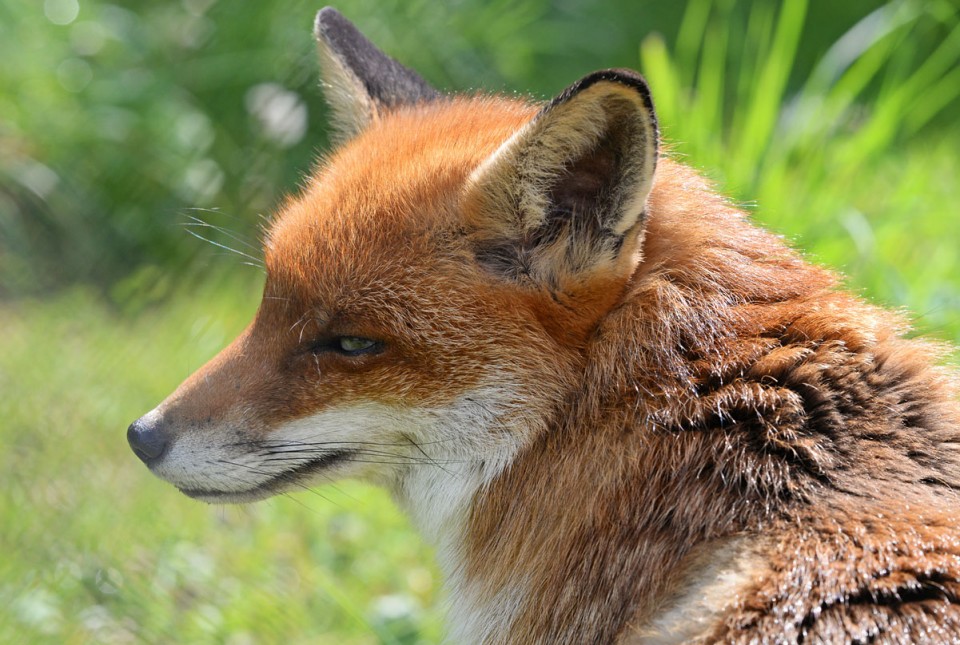
As with cats and dogs, the fur between the pads of foxes is very sensitive to touch (and fox pads are themselves furred, unlike domestic cats and dogs) and probably plays a role in allowing foxes to navigate their way along thin fences, across boulder scree and through the branches of trees with apparent ease. Overall, the vibrissae and inter-pad hairs provide very detailed information on the objects that they touch, as well as detecting air movements that may help reveal the source of potential prey.